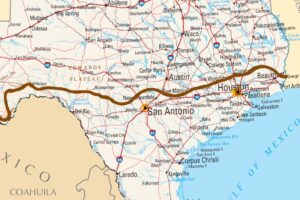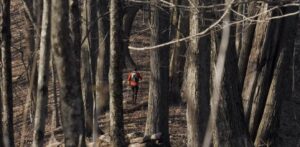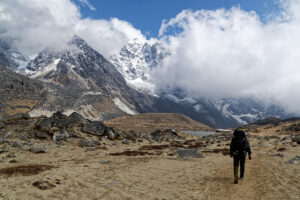Long before we began to chronicle adventures on social media platforms, Edward Jesson put old-fashioned pen to ordinary paper and recounted his single extraordinary journey.
Jesson flourished in the late 1800s and early 1900s in the far northwest corner of North America. At that time, the gold rush coincided with the invention of the “safety bicycle”, the earliest model of the modern chain-driven bike. It had no gears but its tires inflated, cushioning an inevitably bumpy ride. With one of these, Jesson pedaled 1,600km across the harsh breadth of the Yukon and Alaska.

The safety bicycle was the first of the modern two-wheeled, chain-driven bicycles.
His story begins in the Klondike, on the banks of the Klondike River, which joins the Yukon River at Dawson, in Canada’s Yukon, just east of the Alaskan border. When gold was discovered here in 1896, it precipitated a new rush that had intermittently gripped the United States and Canada since the first California strike in 1848.
That initial gold rush brought a stampede of 300,000 dreamers to California, in search of fortune. Most, of course, didn’t find it. Some of them, making the best of the situation, set up stores, saloons, boarding houses, and laundries. They created mining towns, some of which exist to this day.
Once the “stampeders”, as the miners were nicknamed, cleared a region of gold, they hurried on to the next. Now it was the Klondike’s turn to host an invasion.
Jesson made his way to the Yukon, where he established a trading post that catered to the run of prospectors. The income from the post was reliable, but it didn’t rid Jesson of his own gold fever. In 1900, when the action began to shift from the Klondike to Nome, Alaska, Jesson saw his opportunity.
A few years before this, the new safety bike hit the market. Nicknamed the Klondike Bicycle, it was advertised as the answer to every miner’s prayer, something on which a man could “carry his necessary 1,000 pounds of supplies 500 miles from the Chilkoot Pass to the goldfields with ease and comfort.” After he sold two buildings, a cashed-up Jesson spontaneously decided to buy one of these miracle vehicles for himself.
He purchased one from a young fellow he met for a lofty $150, the equivalent of $5,000 today. (Some modern bikes cost even more than that, but still an astonishing sum.)
Everyone thought it was a crazy purchase. “What the h— are you going to do with a wheel?” his own brother asked.
“Going to Nome,” Jesson replied.
The would-be prospector spent the following week in Dawson learning how to ride. He fell so often that he joked that he was “mopping up the streets of Dawson”. Part of the challenge was learning to keep the solid but clunky 23kg bike in the narrow rut of a sled track.
Most of the wonderful details about Jesson’s ride comes from his meticulous journal, which he somehow found time to maintain on the trail. No photos exist of his ride, or of him, so the images here show other Alaskan cyclists of that era.
His harsh training rides around Dawson didn’t deter him: “[The] 23rd of February and the thermometer down to 48 below zero,” he wrote. “The rubber tires on my wheels were frozen hard and stiff as a gas pipe. The oil in the bearings was frozen and I could scarcely ride it. My nose was freezing and I had to hold the handlebars with both hands, not yet being able to ride yet with one hand and rub my nose with the other.”

Although called a “safety bike”, the vehicles — and their riders — were anything but safe.
No one had ever ridden such a distance, and wheelmen, as cyclists were known, commonly suffered snowblindness and frostbite even on shorter jaunts. The bikes often broke down in the extreme subarctic weather. Going such a long distance in such a rough place was a stretch, 70 years before the invention of the mountain bike.
Jesson set out on March 2, 1900. Late winter was not the greatest time to begin a marathon bike journey from the Yukon to Alaska. Yet Jesson felt that he needed to act quickly if he wanted to reach Nome before all the gold was scooped up. Dozens of new prospectors were arriving every day, and a slow ride meant that he would have no chance of staking a lucrative claim. He needed to cover many kilometres each day and minimize sleep if the journey were to be worthwhile.

The new inflatable tires made the bumpy trails easier but often needed fixing.
In his journal, Jesson reported:
“The day I left Dawson was clear and crisp, 30 degrees below zero. I was dressed in a flannel shirt, heavy fleece-lined overalls, a heavy mackinaw coat, a drill parka, two pairs of heavy woolen socks and felt high-top shoes, a fur cap that I pulled down over my ears, a fur nosepiece, plus fur gauntlet gloves.
“On the handlebars of the bicycle, I strapped a large fur robe. Fastened to the springs, back of the seat, was a canvas sack containing a heavy shirt, socks, underwear, a diary in waterproof covering, pencils, and several blocks of sulfur matches. In my pockets, I carried a penknife and a watch.”
On his first day, the rough, snowy trail proved too much for his “wheel” and he carried it most the way. Yet he stubbornly made progress — 120km one day, 80km the next. He sometimes made as little as 40km in a day but averaged about 90km. Once, he covered 160km, impressive even by today’s standards.
On one occasion, he fell off his bike and broke the handlebars. He overcame strong winds and sickness from his soaked clothes. He slept both under the stars and in roadhouses. Sometimes, he barely slept at all from the chill.
Once, he stayed overnight in a roadhouse called Halfway Island. Even in a country awash with impractical dreamers, his quest was an oddity.
“Next morning, March 5, I began to enter the great Yukon flats,” his journal entry reads. “Left the roadhouse 7:30 am and arrived at Fort Yukon at 12 noon. “I left at 1:30 pm with a crowd of about 200 on the high bank watching me…I arrived at a mail cabin 4:20 pm and slept on the floor with eight others, as the bunks were all full. 66 miles for March 5.”
Ignoring the cold, he continued on a well-trodden path, pedaling far and sleeping little.
“The only thermometer that they had there was a little bottle of quicksilver [mercury] which had frozen solid,” he wrote about one roadhouse. “They claimed it was 45 below, and when the quicksilver freezes, the old-timers claimed that it was too cold to work and that your ax would break if you chopped wood.” Mercury, indeed, freezes at -39˚C.
After crossing into Alaska, he met some men who presented him with a harsh truth. It was already “too late to catch gold yourself,” they warned. All the Nome gold had been found. But by now, Jesson had come too far to turn back. For him, the trip was no longer about a hunt for riches. It had become a test of endurance and self-discipline.
After four weeks of radical bike touring, he approached Nome. As he pedaled toward town, locals — scanning the distance through binoculars for fresh dog teams — saw something unusual.
“When I came, the news went around that a dog team was coming. Someone said that it was a fast team, then someone with better glasses saw it was someone on a bicycle. By the time I arrived, a big crowd was there.”

Nome during the gold rush, where Jesson ended his bicycle expedition.
Despite the doubters, he’d succeeded, with little more than a few bruises from occasional falls. Both he and his wheel were in fine form. He hadn’t had a single flat tire or broke a spoke through the entire journey, he reported proudly.
Contrary to what Jesson had been told en route, the Nome gold rush was not over. It actually lasted until 1909.
Little else is known of Jessen or whether he eventually hit the mother lode. But thanks to his journal, we have a remarkable record of one of bike touring’s true pioneers, mastering a route that would be grueling even for today’s trained athletes, on a considerably more impressive wheel.






